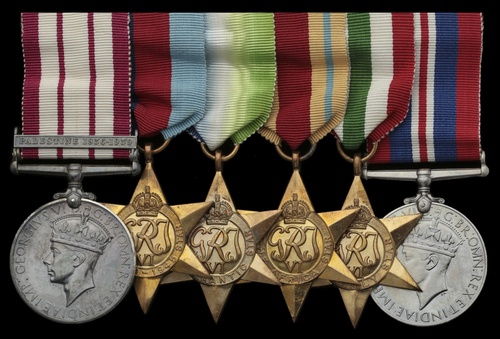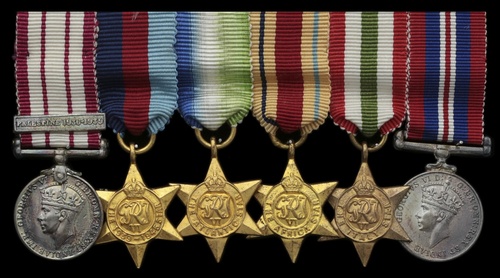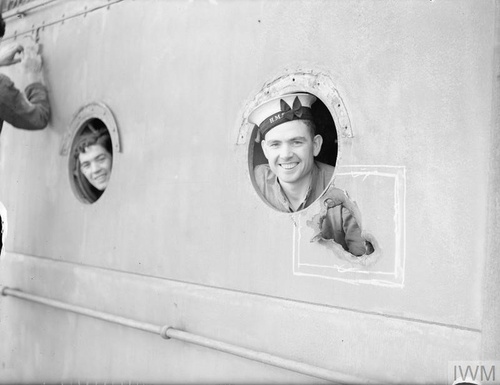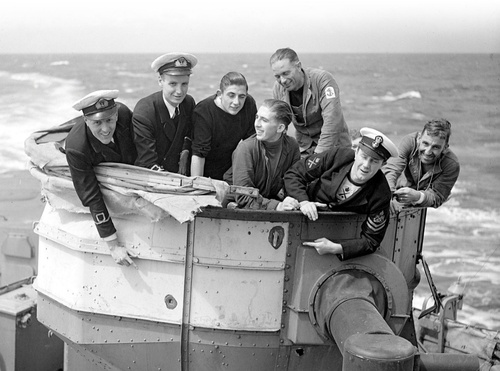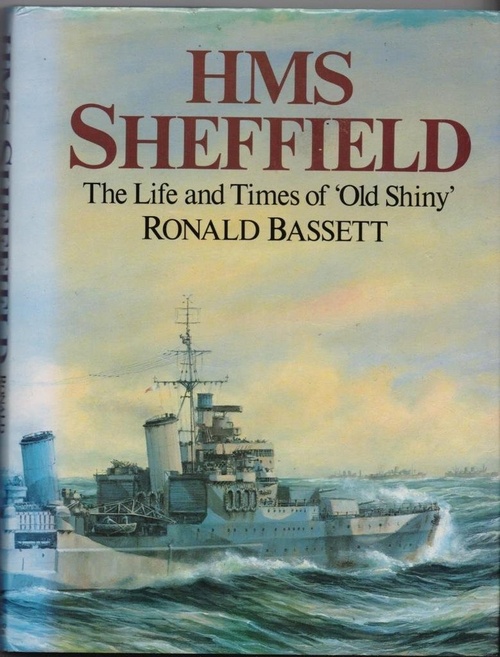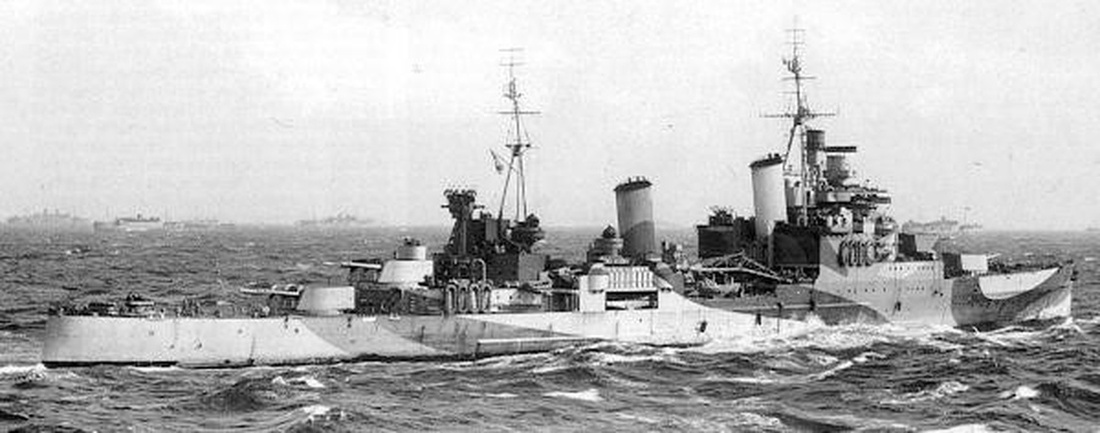Auction: 22003 - Orders, Decorations and Medals
Lot: 393
26-27 MAY 1941: DESTRUCTION OF THE "BISMARCK"
'Much regret to hear of your casualties while shadowing Bismarck. I wish to express my sympathy in the loss of your shipmates. I trust the wounded are progressing favourably. I consider your tenacity and your shadowing was in a large degree responsible for the striking force and destroyers making contact, which fixed the Bismarck and led to her eventual destruction.'
A signal from Vice-Admiral Somerville, congratulating the ship's company of H.M.S. Sheffield on their vital role in the destruction of the Bismarck.
A pre-war Palestine and Second World War campaign group of six awarded to Lieutenant-Commander L. W. C. Burch, Royal Navy
A commissioned 'Gunner R.N.' on the eve of hostilities, he witnessed extensive action aboard the cruiser H.M.S. Sheffield, not least in her close encounter with the Bismarck in May 1941, when she suffered three fatalities and a dozen wounded, the whole to a lethal spread of shell splinters after being straddled by her mighty opponent's 15-inch shells
Naval General Service 1915-62, 1 clasp, Palestine 1936-39 (Gnr. L. W. C. Burch, R.N.); 1939-45 Star; Atlantic Star; Africa Star; Italy Star; War Medal 1939-45, good very fine (6)
Leonard William Charles Burch was born at Deptford, London on 19 November 1905 and entered the Royal Navy as a Boy 2nd Class in November 1921.
'The Old Shiny'
Appointed a Gunner's Mate in January 1933, he was serving as a 'Gunner R.N.' in the cruiser H.M.S. Sheffield on the outbreak of hostilities in September 1939 and remained likewise employed until March 1942; owing to his promotion back in 1933, he did not qualify for the L.S. & G.C. Medal.
As part of the 18th Cruiser Squadron, Sheffield saw action in the Norwegian campaign in April-May 1940 and, as part of Force H, and at the battle of Cape Spartivento off Sardinia on 27 November 1940; she also participated in Operation "Grog", the naval bombardment of Genoa and La Spezia, in February 1941.
Sink the "Bismarck"
But for Burch and his shipmates, it was likely Sheffield's bruising encounter with the mighty Bismarck in May 1941 that proved their most memorable.
On that occasion, Sheffield was charged with shadowing the mighty enemy battleship, a pivotal and lonely role that nearly witnessed her early demise, for she was mistaken by Ark Royal's first Swordfish striking force as the Bismarck. Eleven torpedoes were duly released but owing to some remarkable manoeuvring by Captain C. A. A. Larcom, R.N., disaster was averted: 'Sorry for the kipper', signalled one remorseful Fleet Air Arm pilot.
Sheffield continued her lonely shadowing vigil and nervously awaited the arrival of the Fleet Air Arm's second striking force. Andrew MacIver and Owen Piggott, who were aboard the Sheffield, take up the story:
'She [Bismarck] seemed horribly close to us and we all felt that she must have seen us and at any moment expected a salvo of fifteen-inch shells about our ears, however all was well and nothing happened as we made our way round astern of her keeping about ten to twelve miles away.
The next six hours passed in a flash, every quarter of an hour or so we were making enemy reports on our wireless giving the position, course and speed to our other heavy forces who we knew were trying to concentrate; it was tense work, nobody dared to relax a moment, if we got too close and disclosed our position we should undoubtedly lay ourselves open to being sunk or at any rate badly damaged. Our nearest supporting forces were over fifty miles away so would not have a chance of coming to our assistance.
At 18.30 we got a signal from "Ark" saying that she was going to fly off a striking force of torpedo bombers, they were to contact us and we were to direct them to the target. The striking force arrived about 20.00 and we signalled to them "the enemy is twelve miles dead ahead of us". The visibility was not good at this time, there was a good deal of low cloud about, with several rain squalls all around. The torpedo bombers disappeared into the clouds to attack whilst we waited for the fireworks to start. They found a certain amount of difficulty in getting into position for the attack on account of the low clouds and rainstorms, but suddenly in the murk on our starboard bow we saw spurts of flame and huge red flashes in the sky and realised that the torpedo bombers were going into attack.
It was dull not being able to see clearly, but suddenly we saw first one and then another two of our Swordfish flying towards us. They came past us very low on a level with our bridge and everyone took off their caps and gave them a terrific cheer. We saw that their torpedoes had gone and as one crew flew past we could see their faces wreathed in smiles and they all had their 'thumbs up' as they flashed to us 'hit'. Just after this the rain squall passed and we suddenly saw the second wave of Swordfish going into attack. It was a never to be forgotten sight, there was the Bismarck, one spurting sheet of flame with all her guns firing. We could see the aircraft coming down low over the water and the splash where their torpedoes entered, then all of a sudden there was a huge spurt of blue flame and a gigantic column of spray alongside the stern of the Bismarck. We realised that it must have been a hit or a very near miss.
We watched the last few aircraft attacking when suddenly we saw their fifteen-inch guns open fire. We all thought it was at the aircraft as we thought we were still unseen. The shells fell in the water about three miles away from us, so we did not worry.
Another salvo was fired by the Bismarck and about three quarters of a minute later there was a most deafening crack as four of her fifteen-inch H.E. shells fell either side of us and exploded on impact with the water, two of them fell about forty yards on our starboard beam, the others about fifteen yards off our port quarter. The air was filled with flying splinters and fragments of shell.
We immediately went on to full speed ahead and the Captain gave the order to make smoke but before it could be effective four more salvos fell uncomfortably close, two of them falling just ahead and the other two just astern. Everyone was extremely thankful when the smoke screen became effective and hid us from the Bismarck.
By this time it was after 21.00 and to our great relief we saw five destroyers, Cossack, Maori, Zulu and two others coming at high speed. Our job had been accomplished as we had maintained touch with the enemy till these fellows had arrived to take over the very difficult and dangerous job of shadowing the Bismarck throughout the night.
All this had not happened without us having to pay a price. Unfortunately, some of the splinters had wounded twelve of our A.A. personnel, three poor fellows have since died and two others are seriously wounded. The wardroom was the most damaged spot, several huge fragments of shell came through the ships side and went ricocheting around, piercing three bulkheads before coming to rest. Nobody was there, thank goodness, and only superficial damage was done.
Having turned over the job to the destroyers, we cleared out to the westward to keep clear of the King George V and Rodney who we knew were coming down from the North in addition the Renown was to the Southward and the Norfolk to the East. It was thrilling as the destroyers' enemy reports started come through: "Bismarck is doing twelve knots" (she had been doing twenty to twenty-two knots all the time we had been shadowing her); "Enemy has altered course to 340 0" followed very shortly by "Enemy has altered course to 260 0". Her course seemed to vary with each report, slowly it was being borne on us that her steering gear or rudder must have been affected by the hit that we had observed on her stern.
About 02.00, it now being very dark with no moon and an overcast sky, a signal from Cossack; "I'm going into attack" followed five minutes later with "Attack completed, claim one hit" (with torpedo). At 02.30 approximately from Maori; "Have carried out attack, one hit definite, enemy forecastle is on fire". The enemy's speed after this was reduced, 7-8 knots, and this news was broadcast to our guns' crews who are still standing to at action stations.
The C.-in-C. Home Fleet in the "K.G.V." made a signal saying "Intend to engage the enemy at dawn from the Westward with the Rodney. We then realised the end was very near. Our reports combined with those of the destroyers had led these two ships straight to the enemy.
The sun rose at 07.15 but the light and visibility were very poor due to the constant rain squalls and low clouds and it was not until 08.30, by which time we had closed in to fifteen miles, that the C.-in-C. decided conditions were good enough. We heard "K.G.V." and Rodney open fire and the answering fire from the Bismarck. We were all hoping that we should be allowed to close to finish her off with torpedoes, what a spectacle that must have been. Unfortunately, it was not to be and the Dorsetshire was ordered to sink her with torpedoes. Thus ended a very gallant ship and a brave ship's company. They had fought until there was not a gun in action and their ship nothing but a battered hulk.'
In June 1941, Sheffield caught up with, and sank one of Bismarck's supply tankers, which success was followed up by the destruction of another enemy supply ship in early October.
Having then been assigned to the Arctic run, she was mined off Iceland on 3 March 1942 and returned home for protracted repairs; for further details of Burch's time aboard, which ended in the same month, see H.M.S. Sheffield: The Life and Times of the 'The Old Shiny', by Ronald Bassett.
Advanced to Temporary Lieutenant in late 1942, Burch served in the destroyer Douglas for much of 1943. Having then served in the cruiser Dauntless, he joined the battleship Howe in 1944 and ended the war at the training establishment Collingwood.Advanced to Lieutenant-Commander in May 1945, he died at Meopham, Kent on 13 June 1988.
Sold with a copy of A Communicant's Manual, with interior Royal Hospital School, Greenwich, presentation label to 'Leonard Burch', on the occasion of his confirmation on 7 December 1919; a good quantity of uniform rank insignia, including shoulder boards for the ranks of Lieutenant and Lieutenant-Commander, R.N.; a football medal, awarded to the recipient whilst serving in H.M.S. Royal Sovereign, and a presentation medallion, fashioned from a shell, inscribed 'Lt. Cdr. Burch, R.N., H.M.S. George V, 22nd February 1949, M. of U.D.' along with corresponding miniature awards.
Subject to 20% VAT on Buyer’s Premium. For more information please view Terms and Conditions for Buyers.
Sold for
£480
Starting price
£220

